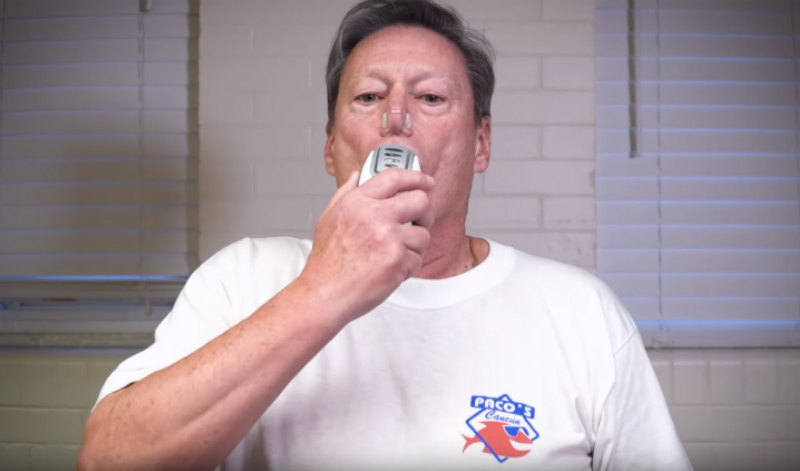Is this any different than the Kundalini Breath of Fire from 5 years ago which produces nitric oxide thus dilating your blood vessels? Which of course your doctor irresponsibly did nothing with. NO protocol, no knowledge of it. nothing.
This 5-minute workout can save your life
Melissa Sammy, MDLinx | May 16, 2019
Five minutes of Inspiratory Muscle Strength
Training (IMST) daily can improve cardiovascular health, enhance fitness
and sports performance, and sharpen cognitive function, according to preliminary clinical trial results from University of Colorado Boulder (CU Boulder) researchers.
A simple workout, IMST involves vigorous inhalation through a hand-held device called an inspiratory muscle trainer that provides resistance.
“It’s basically strength-training for the muscles you breathe in with,” explained study lead Daniel Craighead, PhD, postdoctoral fellow, Integrative Physiology of Aging Laboratory, CU Boulder, Boulder, CO.
The technique was first developed in the 1980s as a non-pharmacological intervention for the improvement of respiratory symptoms in critically ill patients following mechanical ventilation cessation. However, IMST has also been assessed in other studies for the improvement of various respiratory conditions, notably chronic obstructive pulmonary disease, as well as lung capacity improvement in patients with lung diseases.
In a 6-week trial on the effects of IMST on obstructive sleep apnea, University of Arizona researchers found that 30 inhalations a day using a hand-held device resulted in more restful sleep, stronger inspiratory muscles, and lower systolic blood pressure levels (by about 12 mmHg) among participants.
Now roughly half-way through the study, the researchers have noted significant reductions in blood pressure levels and improvements in large-artery function among IMST intervention participants vs those in the control group. Furthermore, cognitive and treadmill test results were superior among participants in the intervention group vs participants in the control group. Specifically, the IMST group was able to run for longer and keep their heart rate and oxygen consumption low when asked to exercise to exhaustion.
“We suspect that as you improve the function of your respiratory muscles, they don’t need as much blood to work and that blood can be redistributed to your legs, so you exercise longer,” said Dr. Craighead.(If you think that you don't understand the creation of nitric oxide and what it does.)
The researchers hope that the ease of the technique coupled with the comfort of a home setting will encourage people to perform the 5-minute workout regularly and enjoy health benefits they might not otherwise receive.
A simple workout, IMST involves vigorous inhalation through a hand-held device called an inspiratory muscle trainer that provides resistance.
“It’s basically strength-training for the muscles you breathe in with,” explained study lead Daniel Craighead, PhD, postdoctoral fellow, Integrative Physiology of Aging Laboratory, CU Boulder, Boulder, CO.
The technique was first developed in the 1980s as a non-pharmacological intervention for the improvement of respiratory symptoms in critically ill patients following mechanical ventilation cessation. However, IMST has also been assessed in other studies for the improvement of various respiratory conditions, notably chronic obstructive pulmonary disease, as well as lung capacity improvement in patients with lung diseases.
In a 6-week trial on the effects of IMST on obstructive sleep apnea, University of Arizona researchers found that 30 inhalations a day using a hand-held device resulted in more restful sleep, stronger inspiratory muscles, and lower systolic blood pressure levels (by about 12 mmHg) among participants.
- See Also: How to get fit without joining a gym
Now roughly half-way through the study, the researchers have noted significant reductions in blood pressure levels and improvements in large-artery function among IMST intervention participants vs those in the control group. Furthermore, cognitive and treadmill test results were superior among participants in the intervention group vs participants in the control group. Specifically, the IMST group was able to run for longer and keep their heart rate and oxygen consumption low when asked to exercise to exhaustion.
“We suspect that as you improve the function of your respiratory muscles, they don’t need as much blood to work and that blood can be redistributed to your legs, so you exercise longer,” said Dr. Craighead.(If you think that you don't understand the creation of nitric oxide and what it does.)
The researchers hope that the ease of the technique coupled with the comfort of a home setting will encourage people to perform the 5-minute workout regularly and enjoy health benefits they might not otherwise receive.
 With IMST, just taking 30 deep
breaths daily (5 minutes) using the hand-held inspiratory muscle trainer
device can improve your cardiovascular health and boost your physical
and cognitive function. (Photo: CU Boulder)
With IMST, just taking 30 deep
breaths daily (5 minutes) using the hand-held inspiratory muscle trainer
device can improve your cardiovascular health and boost your physical
and cognitive function. (Photo: CU Boulder)
No comments:
Post a Comment